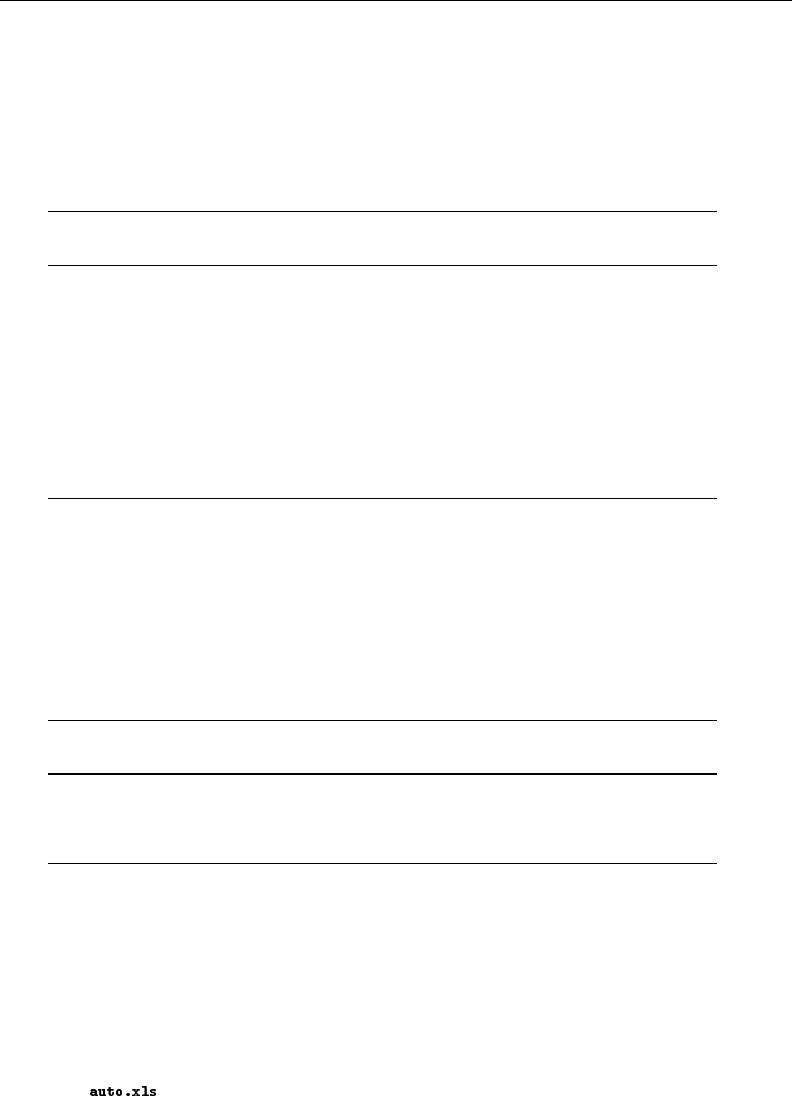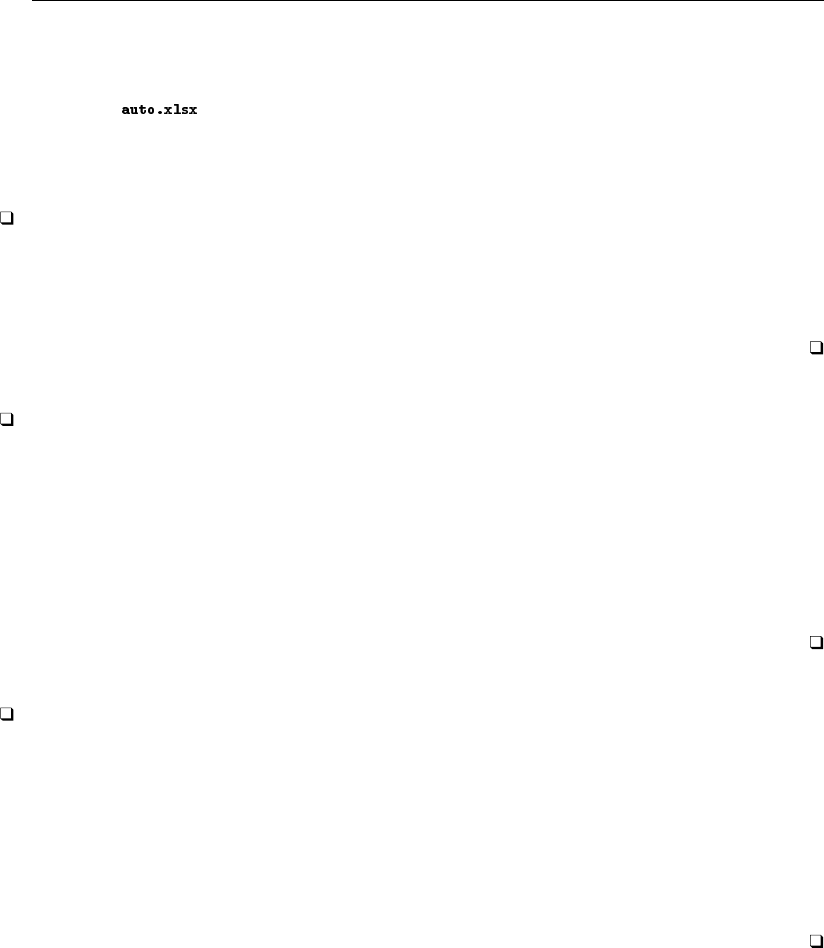
Title stata.com
import excel — Import and export Excel files
Description Quick start Menu
Syntax Options for import excel Options for export excel
Remarks and examples Stored results References
Also see
Description
import excel loads an Excel file, also known as a workbook, into Stata. import excel filename,
describe lists available sheets and ranges of an Excel file. export excel saves data in memory
to an Excel file. Excel 1997/2003 (.xls) files and Excel 2007/2010 (.xlsx) files can be imported,
exported, and described using import excel, export excel, and import excel, describe.
import excel and export excel are supported on Windows, Mac, and Linux.
import excel and export excel look at the file extension, .xls or .xlsx, to determine which
Excel format to read or write.
For performance, import excel imposes a size limit of 40 MB for Excel 2007/2010 (.xlsx)
files. Be warned that importing large .xlsx files can severely affect your machine’s performance.
import excel auto first looks for auto.xls and then looks for auto.xlsx if auto.xls is not
found in the current directory.
The default file extension for export excel is .xlsx if a file extension is not specified.
Quick start
Check the contents of Excel file mydata.xls before importing
import excel mydata, describe
Same as above, but for mydata.xlsx
import excel mydata.xlsx, describe
Load data from mydata.xls
import excel mydata
Same as above, but load data from cells A1:G10 of mysheet
import excel mydata, cellrange(A1:G10) sheet(mysheet)
Read first row as lowercase variable names
import excel mydata, firstrow case(lower)
Import only v1 and v2
import excel v1 v2 using mydata
Save data in memory to mydata.xlsx
export excel mydata
Same as above, but export variables v1, v2, and v3
export excel v1 v2 v3 using mydata
1

2 import excel — Import and export Excel files
Menu
import excel
File > Import > Excel spreadsheet (*.xls;*.xlsx)
export excel
File > Export > Data to Excel spreadsheet (*.xls;*.xlsx)
Syntax
Load an Excel file
import excel
using
filename
, import excel options
Load subset of variables from an Excel file
import excel extvarlist using filename
, import excel options
Describe contents of an Excel file
import excel
using
filename, describe
Save data in memory to an Excel file
export excel
using
filename
if
in
, export excel options
Save subset of variables in memory to an Excel file
export excel
varlist
using filename
if
in
, export excel options
import excel options Description
sheet("sheetname") Excel worksheet to load
cellrange(
start
:end
) Excel cell range to load
firstrow treat first row of Excel data as variable names
case(preserve | lower | upper) preserve the case (the default) or read variable names
as lowercase or uppercase when using firstrow
allstring
("format")
import all Excel data as strings; optionally, specify the
numeric display format
clear replace data in memory
locale("locale") specify the locale used by the workbook; has no
effect on Microsoft Windows
allstring("format") and locale() do not appear in the dialog box.

import excel — Import and export Excel files 3
export excel options Description
Main
sheet("sheetname"[ , modify | replace]) save to Excel worksheet
cell(start) start (upper-left) cell in Excel to begin saving to
firstrow(variables | varlabels) save variable names or variable labels to first row
nolabel export values instead of value labels
keepcellfmt when writing data, preserve the cell style and
format of existing worksheet
replace overwrite Excel file
Advanced
datestring("datetime format") save dates as strings with a datetime format
missing("repval") save missing values as repval
locale("locale") specify the locale used by the workbook; has no
effect on Microsoft Windows
collect is allowed with import excel; see [U] 11.1.10 Prefix commands.
locale() does not appear in the dialog box.
extvarlist specifies variable names of imported columns. An extvarlist is one or more of any of the
following:
varname
varname=columnname
Example: import excel make mpg weight price using auto.xlsx, clear imports columns
A, B, C, and D from the Excel file auto.xlsx.
Example: import excel make=A mpg=B price=D using auto.xlsx, clear imports columns
A, B, and D from the Excel file auto.xlsx. Column C and any columns after D are skipped.
Options for import excel
sheet("sheetname") imports the worksheet named sheetname in the workbook. The default is to
import the first worksheet.
cellrange(
start
:end
) specifies a range of cells within the worksheet to load. start and end
are specified using standard Excel cell notation, for example, A1, BC2000, and C23.
firstrow specifies that the first row of data in the Excel worksheet consists of variable names. This
option cannot be used with extvarlist. firstrow uses the first row of the cell range for variable
names if cellrange() is specified. import excel translates the names in the first row to valid
Stata variable names. The original names in the first row are stored unmodified as variable labels.
case(preserve | lower | upper) specifies the case of the variable names read when using the
firstrow option. The default is case(preserve), meaning to preserve the variable name case.
Only the ASCII letters in names are changed to lowercase or uppercase. Unicode characters beyond
ASCII range are not changed.
allstring
("format")
forces import excel to import all Excel data as string data. You can
specify the numeric display format used to convert the numeric data to string using the optional
argument format. See [D] format.
clear clears data in memory before loading data from the Excel workbook.

4 import excel — Import and export Excel files
The following option is available with import excel but is not shown in the dialog box:
locale("locale") specifies the locale used by the workbook. You might need this option when
working with extended ASCII character sets. This option has no effect on Microsoft Windows. The
default locale is UTF-8.
Options for export excel
Main
sheet("sheetname"[ , modify | replace]) saves to the worksheet named sheetname. If there is no
worksheet named sheetname in the workbook, a new sheet named sheetname is created. If this
option is not specified, the first worksheet of the workbook is used. If sheetname does exist in the
workbook, you can either modify or replace the worksheet.
modify exports data to the worksheet without changing the cells outside the exported range. This
option cannot be specified with replace, nor when overwriting the Excel workbook.
replace clears the worksheet before the data are exported to it. replace cannot be specified
with modify, nor when overwriting the Excel workbook.
cell(start) specifies the start (upper-left) cell in the Excel worksheet to begin saving to. By default,
export excel saves starting in the first row and first column of the worksheet.
firstrow(variables | varlabels) specifies that the variable names or the variable labels be saved
in the first row in the Excel worksheet. The variable name is used if there is no variable label for
a given variable.
nolabel exports the underlying numeric values instead of the value labels.
keepcellfmt specifies that, when writing data, export excel should preserve the existing worksheet’s
cell style and format. By default, export excel does not preserve a cell’s style or format.
replace overwrites an existing Excel workbook. replace cannot be specified when modifying or
replacing a given worksheet: export excel . . . , sheet("", modify) or export excel . . .
sheet("", replace).
Advanced
datestring("datetime format") exports all datetime variables as strings formatted by date-
time format. See [D] Datetime display formats.
missing("repval") exports missing values as repval. repval can be either string or numeric. Without
specifying this option, export excel exports the missing values as empty cells.
The following option is available with export excel but is not shown in the dialog box:
locale("locale") specifies the locale used by the workbook. You might need this option when
working with extended ASCII character sets. The default locale is UTF-8.
Remarks and examples stata.com
To demonstrate the use of import excel and export excel, we will first load auto.dta and
export it as an Excel file named auto.xlsx:
. use https://www.stata-press.com/data/r18/auto
(1978 automobile data)
. export excel auto, firstrow(variables)
file saved

import excel — Import and export Excel files 5
Now we can import from the auto.xlsx file we just created, telling Stata to clear the current
data from memory and to treat the first row of the worksheet in the Excel file as variable names:
. import excel auto.xlsx, firstrow clear
(12 vars, 74 obs)
. describe
Contains data
Observations: 74
Variables: 12
Variable Storage Display Value
name type format label Variable label
make str17 %17s make
price int %10.0gc price
mpg byte %10.0g mpg
rep78 byte %10.0g rep78
headroom double %10.0g headroom
trunk byte %10.0g trunk
weight int %10.0gc weight
length int %10.0g length
turn byte %10.0g turn
displacement int %10.0g displacement
gear_ratio double %14.2f gear_ratio
foreign str8 %9s foreign
Sorted by:
Note: Dataset has changed since last saved.
We can also import a subrange of the cells in the Excel file:
. import excel auto.xlsx, cellrange(:D70) firstrow clear
(4 vars, 69 obs)
. describe
Contains data
Observations: 69
Variables: 4
Variable Storage Display Value
name type format label Variable label
make str17 %17s make
price int %10.0gc price
mpg byte %10.0g mpg
rep78 byte %10.0g rep78
Sorted by:
Note: Dataset has changed since last saved.
Both .xls and .xlsx files are supported by import excel and export excel. If a file extension
is not specified with export excel, .xlsx is assumed, because this format is more common and is
compatible with more applications that also can read from Excel files. To save the data in memory
as a .xls file, specify the extension:
. use https://www.stata-press.com/data/r18/auto, clear
(1978 automobile data)
. export excel auto.xls
file saved

6 import excel — Import and export Excel files
To export a subset of variables and overwrite the existing auto.xlsx Excel file, specify a variable
list and the replace option:
. export excel make mpg weight using auto, replace
file saved
For additional examples illustrating import excel and export excel, see Mitchell (2020,
chap. 2–3).
Technical note: Excel data size limits
For an Excel .xls-type workbook, the worksheet size limits are 65,536 rows by 256 columns.
The string size limit is 255 characters.
For an Excel .xlsx-type workbook, the worksheet size limits are 1,048,576 rows by 16,384
columns. The string size limit is 32,767 characters.
Technical note: Dates and times
Excel has two different date systems, the “1900 Date System” and the “1904 Date System”. Excel
stores a date and time as an integer representing the number of days since a start date plus a fraction
of a 24-hour day.
In the 1900 Date System, the start date is 00Jan1900; in the 1904 Date System, the start date is
01Jan1904. In the 1900 Date System, there is another artificial date, 29feb1900, besides 00Jan1900.
import excel translates 29feb1900 to 28feb1900 and 00Jan1900 to 31dec1899.
See Converting Excel dates in [D] Datetime values from other software for a discussion of the
relationship between Stata datetimes and Excel datetimes.
Technical note: Mixed data types
Because Excel’s data type is cell based, import excel may encounter a column of cells with
mixed data types. In such a case, the following rules are used to determine the variable type in Stata
of the imported column.
• If the column contains at least one cell with nonnumerical text, the entire column is imported as
a string variable.
• If an all-numerical column contains at least one cell formatted as a date or time, the entire
column is imported as a Stata date or datetime variable. import excel imports the column as
a Stata date if all date cells in Excel are dates only; otherwise, a datetime is used.
Video example
Import Excel data into Stata

import excel — Import and export Excel files 7
Stored results
import excel filename, describe stores the following in r():
Scalars
r(N worksheet) number of worksheets in the Excel workbook
Macros
r(worksheet #) name of worksheet # in the Excel workbook
r(range #) available cell range for worksheet # in the Excel workbook
References
Crow, K. 2012. Using import excel with real world data. The Stata Blog: Not Elsewhere Classified.
http://blog.stata.com/2012/06/25/using-import-excel-with-real-world-data/.
Jeanty, P. W. 2013. Dealing with identifier variables in data management and analysis. Stata Journal 13: 699–718.
Mitchell, M. N. 2020. Data Management Using Stata: A Practical Handbook. 2nd ed. College Station, TX: Stata
Press.
Also see
[D] Datetime — Date and time values and variables
[D] export — Overview of exporting data from Stata
[D] import — Overview of importing data into Stata
[M-5] docx*( ) — Generate Office Open XML (.docx) file
[M-5] xl( ) — Excel file I/O class
[RPT] putexcel — Export results to an Excel file
Stata, Stata Press, and Mata are registered trademarks of StataCorp LLC. Stata and
Stata Press are registered trademarks with the World Intellectual Property Organization
of the United Nations. StataNow and NetCourseNow are trademarks of StataCorp
LLC. Other brand and product names are registered trademarks or trademarks of their
respective companies. Copyright
c
1985–2023 StataCorp LLC, College Station, TX,
USA. All rights reserved.
®
For suggested citations, see the FAQ on citing Stata documentation.
